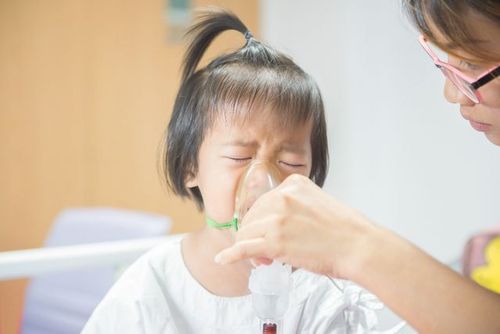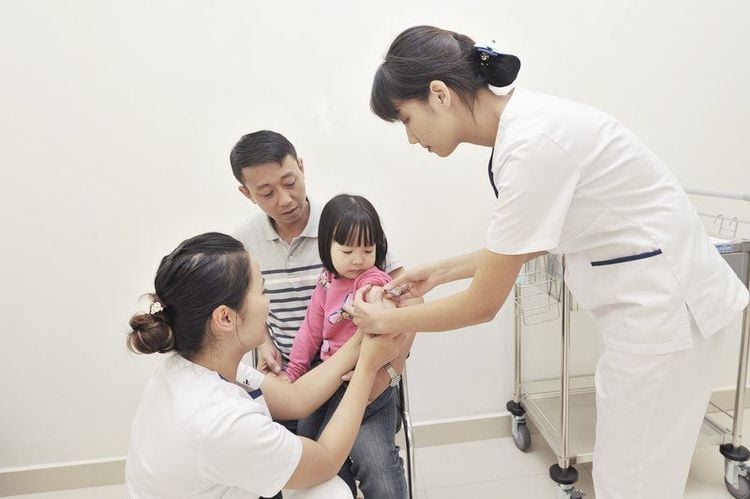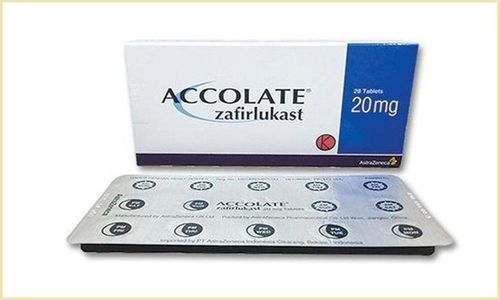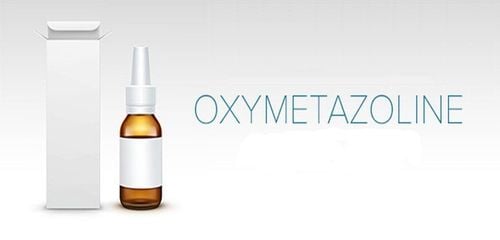This is an automatically translated article.
Asthma is a very common chronic respiratory disease in children, usually treated and controlled with inhaled corticosteroids. However, this drug is both effective and causes some disadvantages for pediatric patients.1. Treatment of bronchial asthma in children
Asthma in children (asthma) is a chronic inflammatory disease of the airways, making them very sensitive to irritants. The airways, mainly the bronchi, of the pediatric patient are prone to edema, constriction, and mucus filling leading to obstruction. This is the cause of the symptoms of recurrent cough, cough at night, feeling of heaviness in the chest, wheezing, shortness of breath when changing weather or exertion,...
If the diagnosis of bronchial asthma is In children who are delayed, they often have seizures that require hospitalization and even death. Therefore, when detecting signs of suspected asthma, parents need to take their child to a respiratory specialist for appropriate diagnosis and treatment of bronchial asthma.
Inhaled corticosteroids are the first choice in the treatment and control of asthma in children of all ages. In addition, an aerosol (nebulizer) form through the nose is also commonly used. Most pediatric patients with bronchial asthma start using inhaled corticosteroids when:
The disease is still mild; Have used inhaled bronchodilators salbutamol or terbutalin but no response.

Hen phế quản ở trẻ em
When asthma is severe, the patient is forced to depend on oral corticosteroids. In addition, patients need to combine corticosteroids with other classes of drugs if asthma is not controlled, even if:
Already taking medium-dose inhaled corticosteroids: Add a long-acting beta 2 agonist. ; Used high-dose inhaled corticosteroids: Add a leukotriene antagonist.
2. Benefits of Inhaled Corticosteroids
2.1. Effective in treating asthma in children In general, long-term use of inhaled corticosteroids, especially at low doses, should be relatively safe. Medicines help reduce the number of severe asthma attacks or no more asthma attacks.
2.2. Preventing side effects of oral drugs According to experts, inhaled corticosteroids - spray will help prevent basically the occurrence of side effects. The advantages of inhaled - sprayed drugs compared to oral - injectable forms are:
Systemic corticosteroids (oral or intravenous): Using a fairly high dose, the drug enters the bloodstream and then reaches the airway mucosa, therefore acts on the whole body; Inhaled corticosteroids: Act directly on the lungs (about 10 - 50%), so the highest concentrations will be in the respiratory mucosa. The rest (80 - 50%) is swallowed in the stomach and inactivated in the liver, the drug concentration in the blood is very low, so it will cause less side effects.
2.3. Reducing the total dose of asthma medicine in children Statistics show that the total dose of inhaled corticosteroids used for prophylaxis in 1 year is much less (maximum only 1/4) compared to the total dose of the drug. required for the treatment of an acute asthma attack (lasting about 10 days).
Comparison of total doses of corticosteroids required for acute oral/injectable asthma (10 days) versus inhaled prophylaxis (1 year)
The above comparison table does not include cases within 1 year Children may have multiple asthma attacks. If this happens, the total dose of oral or injectable corticosteroids that the patient will have to take will be much more.
3. Side effects when using inhaled corticosteroids for a long time
In addition to the benefits stated, the use of inhaled corticosteroids in the treatment of asthma in children still has some potential risks. The possible side effects when using this medicine for children that parents need to watch out for are:
Fungus or thrush: Long-term use of inhaled corticosteroids can cause superinfection of Candida in the nose and mouth of the child; Risk of glaucoma, cataracts: This case occurs only when the child causes inhaled corticosteroids to be inhaled into the eyes; Hoarseness: High doses of inhaled corticosteroids can cause hoarseness; Coughing or wheezing: Occurs after inhalation due to bronchial reaction; Systemic toxicity: When long-term use of inhaled corticosteroids with oral corticosteroids, the baby may initially have hyperadrenocorticism, then abruptly stopping the drug will lead to acute adrenal insufficiency; Decrease in height of children: When used in low and moderate doses, inhaled corticosteroids may have a slight effect on the growth process, specifically a decrease of 1cm in height in the first year of treatment. However after that the height will not be affected anymore; Other side effects: The drug can cause headache, sore throat, nasal irritation, sneezing, nausea, vomiting, nosebleeds, rash, itching, swelling of the face, even anaphylaxis, but rarely.

Trẻ có thể gặp tình trạng nôn hoặc buồn nôn
4. Measures to prevent side effects
Gargling after taking the medicine The rinsing of the mouth after using inhaled corticosteroids helps to remove most of the excess medication that remains in the patient's mouth and throat. Patients need to drink clean water, tilt their neck and gently rinse their mouth and throat, then spit this water out. Repeat 2 times to help completely remove excess corticosteroids, reducing the risk of thrush, thrush or hoarseness.
Use medicine through the spacer To prevent and overcome the side effects of the medicine, it is recommended that the child inhale the medicine slowly through the spacer.
Nutrition When treating bronchial asthma in children with inhaled corticosteroids, parents need to increase the use of potassium-rich foods for their children, for example, eat a lot of oranges, bananas, grapes, ... and supplement. daily calcium.

Tiêm phòng vắc-xin phòng bệnh
Influenza vaccination Influenza vaccination should be given every year, to help prevent infection and thereby significantly reduce the frequency of bronchial/asthma attacks.
Take the correct dose as prescribed If the child has hoarseness, consult a doctor to reduce the dose temporarily. The use of inhaled corticosteroids to treat asthma in children should be monitored by a specialist, especially when combined with oral corticosteroids to avoid causing serious side effects. In general, inhaled corticosteroids should only be combined with adequate oral doses, in a short course if necessary.
In addition, children being treated with inhaled corticosteroids should also have their height monitored regularly.
In general, to successfully treat bronchial asthma in children, it is necessary to have close cooperation between doctors, pediatric patients and families. Inhaled corticosteroids are effective in reducing or completely eliminating asthma attacks, are quite safe, and reduce the total dose compared to oral corticosteroids. However, the drug also has the risk of causing some side effects that parents need to know how to avoid. If the accompanying undesirable symptoms persist and are severe, the drug should be discontinued and the doctor immediately informed.

Khám và điều trị bệnh lý trẻ em tại Vinmec
Vinmec International General Hospital is one of the hospitals that not only ensures professional quality with a team of leading medical doctors, modern equipment and technology, but also stands out for its examination and consultation services. comprehensive and professional medical consultation and treatment; civilized, polite, safe and sterile medical examination and treatment space.
Customers can directly go to Vinmec Health system nationwide to visit or contact the hotline here for support.
MORE:
Asthma: Causes, symptoms, diagnosis and treatment Instructions for use of metered dose inhalers in children Asthma symptoms in children













